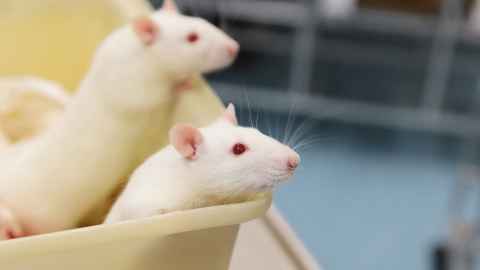The 3Rs: Replacement, Reduction and Refinement
All animal research and teaching activity at the University is guided by the ethical principles of “the 3Rs”. Researchers must address these in ethics applications.

Replacement
Animals are replaced by non-living alternatives or non-sentient animal models where possible.
We look forward to the day when animals are no longer needed in research and strive to use non-animal-based research methods as technology permits.
Over decades science has made many advances in in vitro ‘test tube’ and in silico ‘computer’ models for research, as well as with other replacement techniques. Where possible, researchers must replace sentient animal models, as detailed in the Animal Welfare Act 1999 (the Act) with non-sentient animals and non-living techniques.
The University has replaced several animal-based teaching laboratories with non-animal-based methodologies, so a specific strain of mice is no longer required. Several research groups have replaced the first stages of drug screening with the use of organoid models.
Reduction
The number of animals is reduced to the minimum required for valid results. When animal models are required, researchers explore ways to reduce the use of animals. This includes using the least number of animals possible to harness statistically significant results and obtaining more information from a given number of animals.
The use of small pilot studies is encouraged, prior to doing new work on larger numbers of animals. Researchers also reach out to other research programmes which may be able to employ the same animals or animal tissue for their activities.
These steps reduce the overall number of animals used in animal research and the numbers of animals needing to be euthanised. The sharing of animals and tissues is required if possible and is addressed in the ethics application.
The University judiciously breeds animals, although it is not possible to breed only what is needed and supports the rehoming of animals as appropriate and rehomes animals in partnership with the New Zealand Anti-Vivisection Society (NZAVS) and Helping You Help Animals (HUHA). This reduces the number of animals that need to be euthanised.
The few remaining teaching labs have further decreased the number of animals used by increasing the number of students per animal and allowing for ‘opt in’ or ‘opt out’ laboratories.
Refinement
The methods used are refined so that the welfare benefits to animals are maximised and the impact on animal welfare minimised. Providing animals with the best life possible is good for animal welfare and results in more robust research outcomes. Stress in an animal’s environment must be mitigated by providing appropriate husbandry techniques.
Husbandry refers to adequate housing, nutritionally sound food, clean water, safe handling, and a comfortable and enriched environment to reduce stress and boredom and to promote natural behaviours. Researchers also seek ways to design their research to minimise impacts on individual animals and increase positive welfare.
This includes reducing the duration of manipulations to the minimum necessary, using treats and increased affection as rewards, and using the least stressful technique to accomplish a task. It also includes ensuring appropriate pain relief before and after manipulations and objectively determined study and humane endpoints for experiments.
Additionally, the use of the PREPARE guidelines is recommended for planning effective animal-based research to implement the 3Rs and identify factors which can affect the validity of research as well as the use of the ARRIVE guidelines, “a checklist of recommendations to improve the reporting of research involving animals – maximising the quality and reliability of published research, and enabling others to better scrutinise, evaluate and reproduce it.”
The University introduced tunnel handling, a lower stress form of handling mice, for mouse strains that are more anxious or highly strung and will now work to do so with all strains.
Group housing and playpens for rabbits have been introduced with much success. Jellies rodents like have been used for accurate dosing of substances, avoiding the need for restraints and feeding tubes.
Some research groups have introduced rat tickling to habituate rats to handling and improve their welfare. While not appropriate for all rats, for many it contributed to positive welfare. Animals that do not need to be euthanised for tissue collection may also be rehomed, if appropriate and in the best interest of the animals.